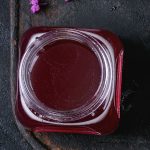Description
Making lilac jelly at home is easy, and canning it is a fun springtime project for the two weeks lilac bushes are in bloom. This lilac jelly recipe is beginner-friendly and tastes amazing.
Ingredients
Scale
- 4 cups lilac petals
- 4 cups sugar
- 4 tablespoons powdered pectin or 1 packet of liquid pectin
- 4 cups boiling water
- 2 tablespoons lemon juice
Instructions
- Harvest ten lilac flowers in full bloom. These will yield 4 cups of lilac petals ready for jellying.
- Bring 5-6 cups of water to a rolling boil in a large pot as you prepare the lilacs.
- Remove the stems and leaves from the flowers.
- Rinse the flower petals in cool water and transfer them to a heat-safe quart-size mason jar.
- Make lilac tea or lilac-infused water by steeping the flowers in boiling water. Pour 4 cups of boiling water into the mason jar to cover the flowers. A color change may happen when you add the hot water, depending on the color of the lilac blossoms.
- Cover the Mason jar and allow the lilac petals to infuse flavor and aroma into the water. 10 minutes is the minimum amount of time, but soaking them for 6-12 hours makes more flavorful lilac tea and jelly.
- As the petals steep, get your water bath canner and canning utensils ready. Wash the jars, lids, and ring bands in warm soapy water. Keep the jars and rings in hot water for hot-packing.
- Lower a clean canning rack into the canner and fill it halfway with fresh water. Heat the canner over medium-high heat and bring the water to a 180°F simmer.
- After steeping, use a cheesecloth or fine-mesh strainer to strain the tea into a large, non-reactive jam pot or saucepan. Squeeze lightly to get more floral flavor and all the liquid. The yield will be 3½-4 cups of lilac tea.
- Add lemon juice. The color of the tea will change because of the change in pH. This will be the final jelly color. If preferred, add some blueberry or blackberry juice to darken the color.
- Add the powdered pectin and bring the mixture to a rolling boil.
- Add the 4 cups of sugar. Stir thoroughly to dissolve all the sugar, and boil the jelly for another minute. Skim and remove any foam that forms.
- Ladle the hot jelly into hot half-pint jars and leave ¼-inch headspace. You’ll need five half-pint jars.
- Remove bubbles with a plastic spoon. Wipe the rims of the jars with a dampened paper towel and center new lids on the jars. Fasten screw bands on until they are fingertip-tight.
- Load the jars into the canner, being careful not to tilt or turn the jars. Ensure the water covers the jars by 1-2 inches.
- Heat the water to a rolling boil, then cover the canner with the lid. Process the jelly jars for 10 minutes if your elevation is between sea level and 1,000 ft. Adjust for altitude by adding 1 minute to the processing time for every 1,000 feet in altitude.
- Take the canner off the heat and open its lid to let out steam. Wait 5 minutes, then use a jar lifter or canning tongs to remove each jar. Rest the jars upright on a counter lined with warm towels.
- Let the jars cool to room temperature for 12-24 hours. Avoid retightening any lids.
- Unfasten the ring bands to inspect the jar seals. The seals shouldn’t flex when pressed. Use new lids to reprocess any unsealed jelly jars within 24 hours.
- Place labeled, sealed jars in a cool, dry place.
- Prep Time: 1 hour
- Canning Time: 10 minutes
- Cook Time: 20 minutes
Nutrition
- Serving Size: 1 tbsp
- Calories: 41kcal
- Sugar: 10g
- Sodium: 1mg
- Fat: 1g
- Saturated Fat: 1g
- Carbohydrates: 11g
- Fiber: 1g
- Protein: 1g
